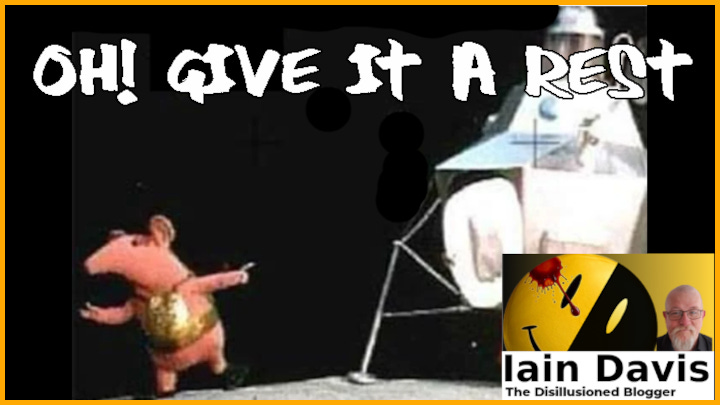Oh! Give it a Rest! Iain Davis
Tue 5:57 pm +01:00, 9 Jul 2024
Recently the Telegraph published “I’d Like to believe the Moon landings were fake – the alternative is far bleaker.” It’s an anonymous editorial, posing as a movie review. The former Telegraph journalists, who has now been officially labelled a “conspiracy theorist,” James Delingpole, observed:
Telegraph does limited hangout on fake moon landings so that 77th can then swarm over the comments and put moon landing deniers in their place.
Delingpole’s jibe at the UK Army’s online hybrid warfare unit, 77th Brigade, probably wasn’t too far removed from the truth. Though they are perhaps more likely to be hoovering up “intel” from the replies to Delingpole’s tweet—yes “tweet” I say—than the virtually dead comments section in the Telegraph.
Whether you believe humanity has been to the moon or not, the Telegraph piece wasn’t really about that, nor was it a movie review. It made some interesting points about demise of the productive economy in the West and the “Age of Entitlement” theories of Christopher Caldwell, etc., but that wasn’t it’s real subject matter either.
It was subtle, but pure propaganda. In fact it’s subtlety made it particularly pernicious and, as is often the case, more effective propaganda.
By placing Moon landing scepticism within the context of a disillusioned public malaise, the article offers understanding and, at times, acceptance of the reasons why people might doubt that Armstrong et al., wandered around on the Lunar surface. The Telegraph reader is invited to develop some empathy for the poor deluded souls who question the Moon landing story because they “exist in oblique relation to empirical reality.”
The problem is, you see, that these unfortunate fools are “conspiracy theorists” and if there’s one thing we know about conspiracy theories is that “they make most sense when understood not as factual claims but as emotional stories – allegories.”
The Telegraph explains:
[. . .] a great deal of effort has been expended over the decades trying to use evidence to dispel the conspiracy theories. But attempting to debunk them logically is to misunderstand what such claims are communicating. [. . .] Why won’t we all just accept the facts? Perhaps because most people aren’t interested in or persuaded by facts alone.
Interesting, hmm? So what are the facts that reveal the “empirical reality”?
Well, with regard to the Moon landings, according to the Telegraph, we can be absolutely certain it happened for the following reasons:
Humans first landed on the Moon on July 20 1969. More than half a billion people watched on television as Neil Armstrong and Aldrin took their first steps on the arid surface. They left behind an American flag, a patch honouring the fallen crew of Apollo 1, and a plaque that read: “We came in peace for all mankind.” The sixth Apollo mission to land humans on the Moon concluded three years later. The Moon has not been visited by astronauts since December 1972.
There we go. Facts established, say no more.
Of course some people might wonder why NASA claims it has yet to overcome the tricky problem of getting people through the Van Allen radiation belt alive when it did so repeatedly more than fifty years ago. Perhaps others wonder why there is video of the Apollo astronauts faking imagery of a distant Earth while in low Earth orbit, at a time when they should have been 125,000 miles away. Why can’t we “see” the flags or indeed the rest of the debris they supposedly left up there? How did they get the batteries to work in Lunar conditions, who took the photographs, why does the LEM look like the Clangers made it?
Personally, I think the idea that the Apollo Moon Landings were all—OK, mostly—a resounding success about as plausible as the notion that bricks make good kites. But as I said, the Telegraph article isn’t really about that and who cares what I think?
What the Telegraph wants its readers to believe is that facts are established by consensus. Everyone saw the Moon landings on the telly, loads of people say it happened and, most crucially of all, esteemed members of the epistemic authorities say it happened. No one needs to think anything else. Just trust whatever authority tells you.
Expanding on its unhinged opinions about the nature of evidence, facts and knowledge, the Telegraph ploughs ahead with, what James Corbett called, “the factchecker trick.”
Using a composition fallacy, you take the most absurd claim you can find, insist it is representative of a whole swath of opinion—even when it isn’t—debunk it and then, Voila! Every other argument is “debunked” by association. It doesn’t matter that there is no actual association, you just claim there is and the job’s a good’n.
I’ll let the Telegraph demonstrate:
Among the many conspiracies that circulated concerning the Covid vaccination programme, one common claim was that vaccines were really a covert programme to inject each of us with a microchip that would allow Bill Gates to track our whereabouts or even control our minds. This is, we can safely say, not true.
Well, we can certainly say there is no evidence to suggest Bill Gates was putting mind-controlling microchips in the jabs. Equally, we can say there is no evidence that this was a “common claim.” In fact, those of us with a more sceptical bent might wonder just who it was that ever suggested the daft story in the first place.
But it is certainly easy to “debunk.”
And moving on to the necessary association:
Conversely, though, the vaccination programme really was accompanied by the international rollout of digital “vaccine passports”, which link vaccination status to other biomedical data, as well as official state identifiers. And while it’s no longer in active use, this architecture now enables states potentially to track individuals’ movements, and to index freedoms previously taken for granted – such as travel or access to public spaces – to co-operation with who-knows-what future mandatory medical interventions. However, this probably isn’t a sinister plot, whatever the conspiracists may say.
Now I distinctly remember people pointing this out when it was happening. I was one of them. Indeed, I remember quite a few of us wacky conspiracy theorists banging on about the construction of a bio-security state of exception and how this wasn’t a very good idea. Well, not for human beings anyway.
We certainly did allow the state to construct the “architecture” that will enable it “to track individuals’ movements, and to index freedoms previously taken for granted.”
But I don’t recall anyone who highlighted this self-sacrificial folly simultaneously claiming that Bill Gates had spiked the jabs with brain chips. That little asserted association from the Telegraph appears to be bullshit.
And may I freely state that restricting travel, curtailing our freedom of association, locking us in urban silos and removing our right to bodily autonomy, based on unsubstantiated claims made about a cold, sounds like a pretty bloody “sinister plot” to me.
But that’s must be because I’m a conspiracy theorist.
Apparently, according to the Telegraph, while people were pointing toward the evident fact that the state was using Covid to erect a technocratic enslavement grid, and while that is all now freely admitted, to have warned people about it at the time was to engage in conspiracy theory.
Furthermore, if we follow the Telegraph’s . . er . . logic, the people who were all completely right—the conspiracy theorists—should never be heeded again because they are a bunch of loonies who actually think Bill Gates is a lizard demon.
This is all true because the Telegraph says it is true. So, as it increasingly dawns on the population that a stringent system of bio-security “state identifiers” is actually going to be used to control them, it is important to remember that this is not evidence of a “sinister plot.”
It might feel a bit oppressive but, according to the Telegraph, that’s just the “discomfiting sense” that comes when technological innovations “increasingly intrude into our physical, embodied lives.” So just accept it, and don’t worry about it Telegraph readers. There’s nothing to see here and if you suspect there is you are a conspiracy theorist and all your friends will think you’re an idiot.
Capiche!
The Telegraph’s propaganda is subtle because it is inserted into an article that provides the reader with seemingly rational analysis, but there’s nothing rational about it. The propaganda is covert and mendacious. You might call it “sinister.”
Rounding off its propaganda sandwich, despite the “fact” that today’s technological capability makes the technology of the the 1960’s look like a stone cartwheel, the Telegraph explains that the reason we can’t get to the Moon now is because “the achievements of mid-20th-century America were the achievements of a different civilisation, one now as distant and mysterious as the Moon.”
But the Moon is not mysterious is it? According to the “official story,” people were playing golf on it and driving around the Moon in chuffin’ beach buggies more than half a century ago. We just can’t do that today because NASA has lost all the telemetry data and archive material of mankind’s “greatest ever achievement” and says it has forgotten how to fly to and, more importantly, land on and then fly back from the Moon.
Oh! Give it a rest!
















